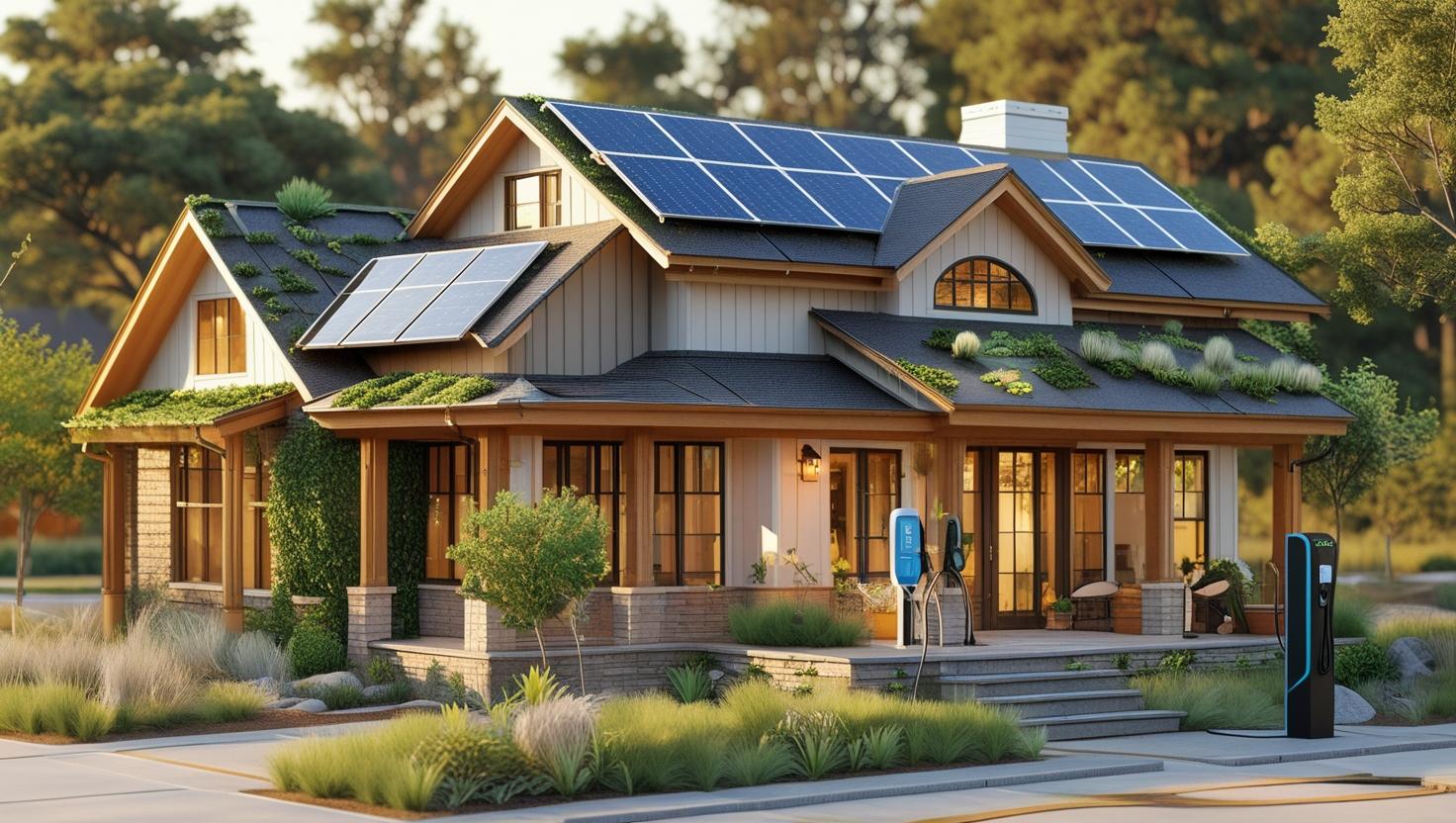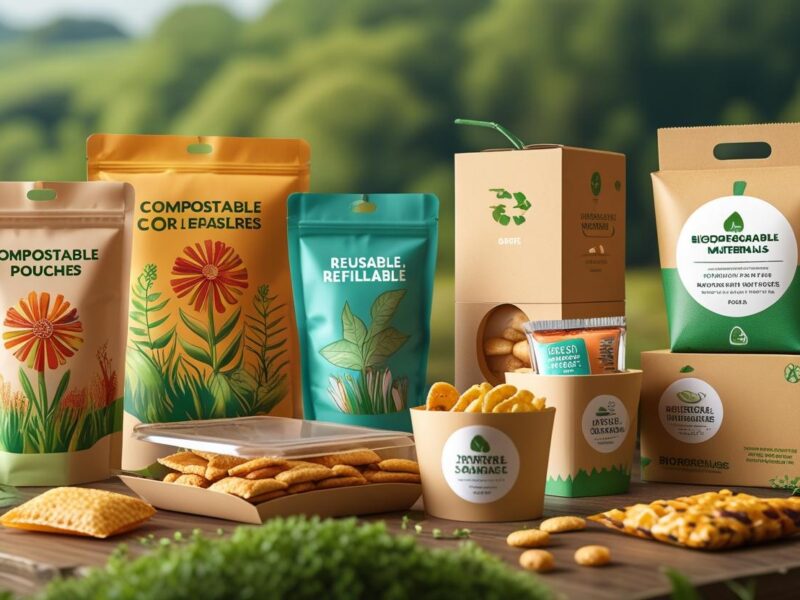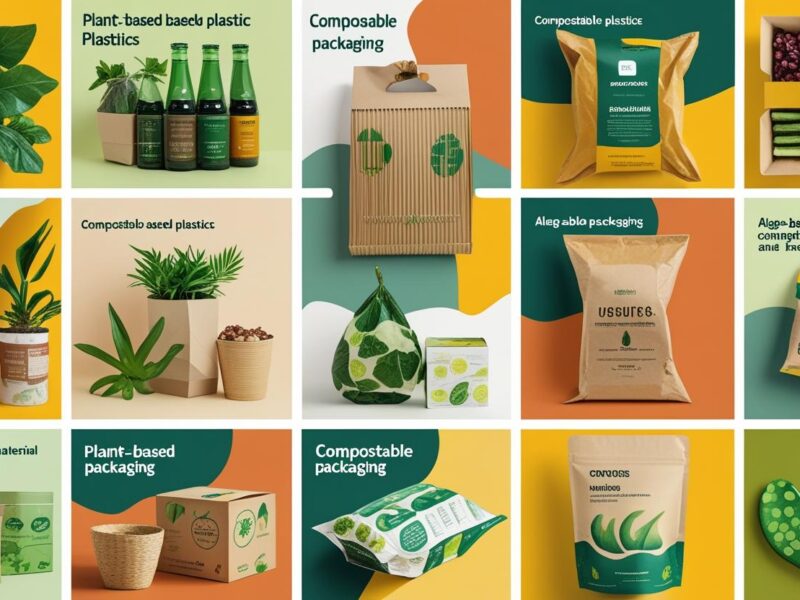Discover the top sustainable house features that make homes eco-friendly, energy-efficient, and cost-effective. Learn how to build your dream green home.

What Makes a Sustainable Home?
As the world increasingly turns its focus toward environmental sustainability, building and living in eco-friendly homes has become a priority. Sustainable houses are designed to reduce environmental impact, promote energy efficiency, and create a healthier living space for their occupants. Sustainable house features focus on the use of renewable materials, energy-efficient appliances, and eco-conscious designs that minimize waste and lower carbon footprints.
In this article, we’ll explore some of the most important sustainable house features that are revolutionizing the way we think about homeownership. Whether you’re planning to build a new house or upgrade your current one, these green features can make a world of difference for the environment, your wallet, and your overall quality of life.
What Are Sustainable House Features?
Sustainable house features refer to design elements, technologies, and materials that contribute to reducing energy consumption, minimizing waste, and promoting a healthy, eco-friendly living environment. These features focus on integrating renewable energy sources, optimizing natural resources, and using sustainable materials to create homes that have a minimal environmental impact.
Sustainability is more than just a buzzword—it’s about making choices that contribute to long-term ecological health. A sustainable home is one that meets the needs of its inhabitants without compromising the ability of future generations to meet their own needs.
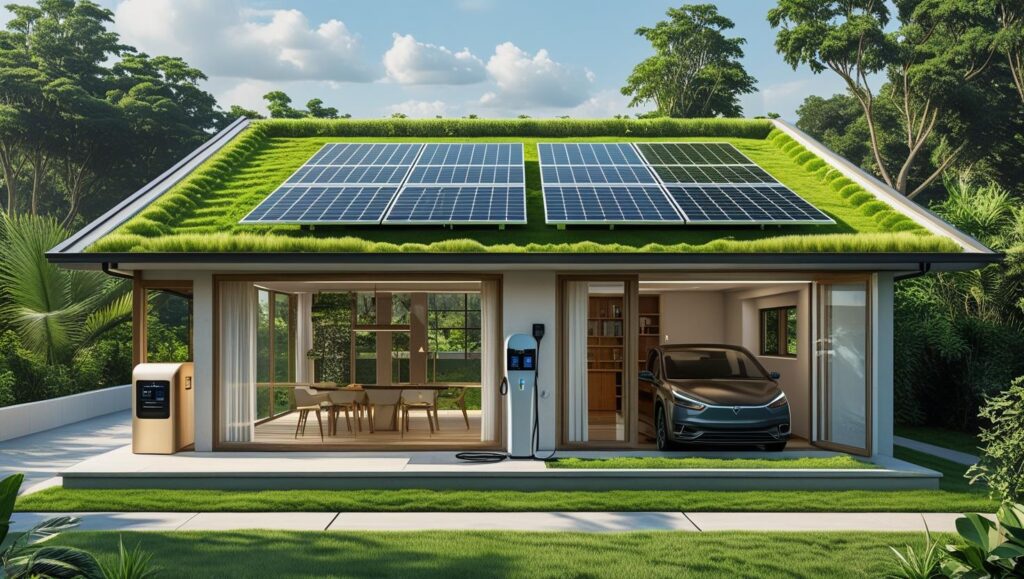
Energy-Efficient Features That Save You Money
Solar Panels: Harnessing the Power of the Sun
One of the most popular and effective sustainable house features is the integration of solar panels. Solar energy is renewable, abundant, and reduces dependency on non-renewable energy sources. Solar panels allow homeowners to produce their own electricity, significantly reducing their monthly utility bills. With the added benefit of government incentives and tax breaks, solar energy is a smart investment for eco-conscious individuals looking to reduce their carbon footprint.
Energy-Efficient Windows and Insulation
Proper insulation and energy-efficient windows are essential for maintaining a comfortable indoor temperature without overusing your heating and cooling systems. Double-glazed windows with low-emissivity coatings minimize heat transfer, helping to keep your home warm in winter and cool in summer. Insulation made from sustainable materials, like cellulose or recycled denim, can further enhance energy efficiency by reducing the need for heating or air conditioning.
Smart Thermostats and Lighting
Investing in smart thermostats and LED lighting systems can have a profound impact on a home’s energy consumption. A smart thermostat adjusts the temperature of your home based on your schedule and activity, ensuring energy is used only when necessary. Additionally, switching to LED lighting—which uses far less energy than traditional incandescent bulbs—can lower electricity use and reduce your carbon footprint.
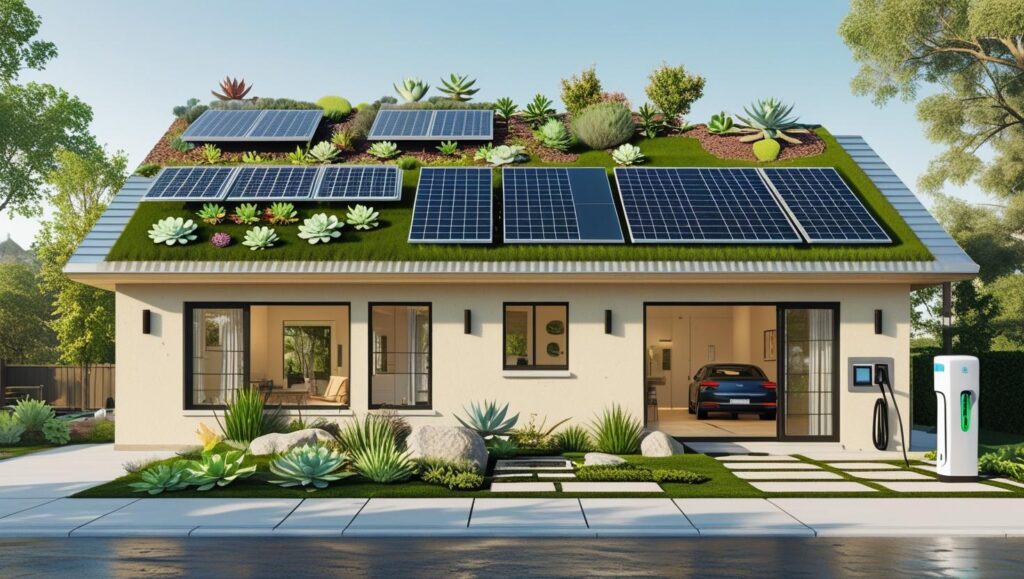
Water-Saving Sustainable Features
Rainwater Harvesting Systems
Water scarcity is a growing global issue, and sustainable homes are doing their part by incorporating rainwater harvesting systems. These systems collect rainwater from the roof and store it in tanks for use in irrigation, landscaping, or even indoor purposes, reducing reliance on municipal water systems.
Low-Flow Fixtures and Appliances
Another important feature of sustainable homes is the use of low-flow faucets, showerheads, and toilets. These water-saving fixtures reduce the amount of water used daily, which helps conserve natural resources and reduce water bills. In addition, eco-friendly dishwashers and washing machines use less water and energy, ensuring that you don’t waste valuable resources while maintaining high-performance functionality.
Sustainable Materials for a Healthier Home
Recycled and Repurposed Building Materials
Building a sustainable home goes beyond energy efficiency—it also involves choosing materials that are either recycled or repurposed to reduce the environmental impact. For example, using reclaimed wood for flooring or recycled steel for framing reduces the need for new materials and cuts down on waste. Additionally, bamboo is a popular sustainable material due to its fast growth rate and ability to regenerate without replanting.
Non-Toxic and Natural Paints and Finishes
Traditional paints and finishes often contain harmful chemicals that can affect indoor air quality. Sustainable homes use low-VOC paints and natural finishes to minimize exposure to toxic substances. These eco-friendly products not only improve air quality but also help create a healthier environment for residents, reducing the risk of asthma or allergies.
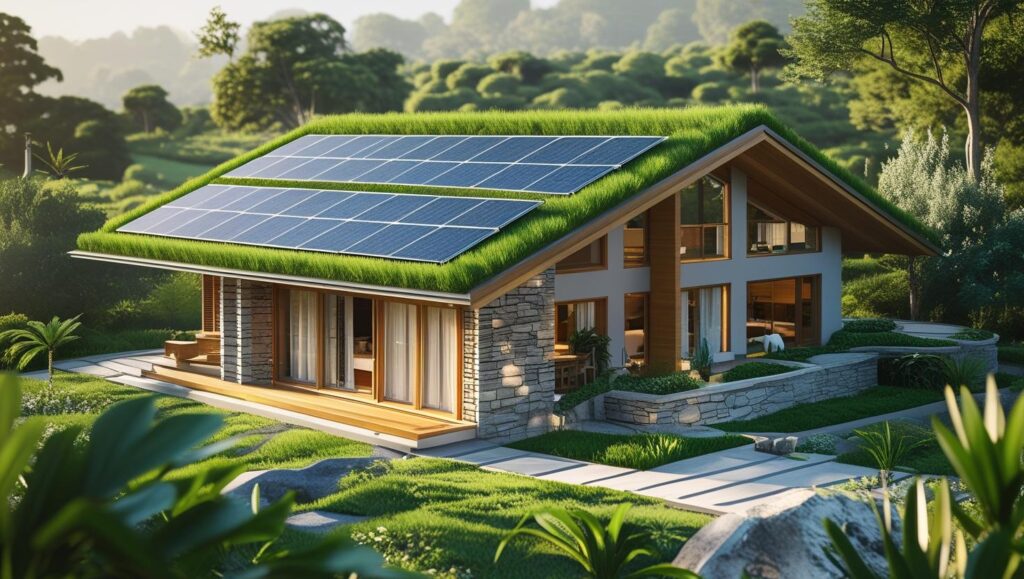
Passive Design Elements for Energy Conservation
Orientation and Natural Ventilation
Passive design elements focus on the strategic placement of your home to maximize natural heating, cooling, and lighting. By designing your home to take advantage of sunlight and prevailing winds, you can reduce the need for artificial lighting and temperature control. South-facing windows can allow for optimal sunlight exposure in the winter, while overhangs or shading devices can protect your home from excessive summer heat.
Green Roofs and Walls
Green roofs and living walls are becoming increasingly popular in sustainable homes for their ability to improve energy efficiency, increase insulation, and reduce urban heat islands. These natural elements help regulate temperature and provide insulation, ultimately reducing the need for artificial heating and cooling. Additionally, green roofs improve air quality and support biodiversity by providing habitats for plants and animals.
Sustainable Landscaping for a Greener Environment
Native Plantings and Xeriscaping
When designing the landscape around your sustainable home, it’s important to choose plants that are native to your region. Native plants are adapted to the local climate and require less water, pesticides, and fertilizer. Xeriscaping, or drought-tolerant landscaping, reduces the need for irrigation and minimizes water waste.
Composting and Organic Gardening
Sustainable landscaping also involves composting organic waste, which helps reduce landfill contributions and enriches the soil in your garden. By using compost and organic gardening techniques, homeowners can grow their own food while minimizing the use of synthetic fertilizers and pesticides.
The Future of Sustainable Homes: Innovation and Trends
Energy Storage Systems
One of the latest trends in sustainable homes is the integration of home energy storage systems, such as batteries that store excess solar power for later use. This allows homeowners to continue using solar energy even when the sun isn’t shining, reducing reliance on the grid and improving energy independence.
Smart Home Integration
Smart home technologies, such as voice-controlled assistants, automated lighting, and intelligent security systems, are becoming more common in sustainable homes. These devices not only improve convenience but also contribute to energy efficiency by optimizing how energy is consumed throughout the house.
Frequently Asked Questions
- What are the main features of a sustainable home?
A sustainable home typically includes energy-efficient appliances, solar panels, water-saving fixtures, sustainable building materials, and eco-friendly landscaping. These features help reduce the home’s environmental footprint. - How can I make my existing home more sustainable?
You can improve your home’s sustainability by upgrading to energy-efficient windows, installing solar panels, using smart thermostats, switching to LED lighting, and implementing water-saving devices like low-flow showerheads and faucets. - What is the cost of building a sustainable home?
While the upfront cost of building a sustainable home can be higher due to the use of eco-friendly materials and technologies, the long-term savings on energy bills and water usage can make it a worthwhile investment. - Do sustainable homes require more maintenance?
Sustainable homes often require less maintenance because they are built with durable, high-quality materials and designed to be more energy-efficient. However, regular maintenance is still essential to keep systems like solar panels and energy storage functioning optimally. - Can sustainable homes be stylish and modern?
Absolutely! Sustainable homes can incorporate modern designs, sleek lines, and stylish finishes while still maintaining eco-friendly features. Sustainability and aesthetics can go hand in hand with thoughtful planning and design.
Building a Sustainable Future Starts at Home
Investing in sustainable house features not only helps protect the environment but also provides long-term benefits for homeowners. From reducing utility bills to improving air quality and creating a more comfortable living space, sustainable homes offer numerous advantages.
Whether you’re building a new home or renovating an existing one, consider incorporating these eco-friendly features to create a space that is both beautiful and environmentally responsible. By choosing sustainable materials, harnessing renewable energy, and prioritizing energy efficiency, you can play a key role in building a greener, more sustainable future.
As awareness about environmental challenges grows, sustainable houses are becoming more than just a trend—they are an essential part of shaping a better, more sustainable world for generations to come. Take the first step today and embrace the green home revolution!
